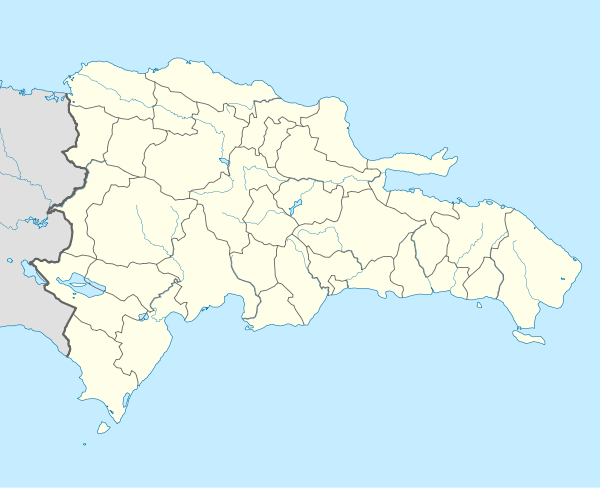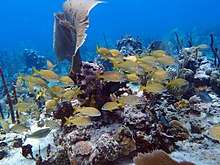Catalina Island (Dominican Republic)
Catalina Island or Isla Catalina is a tropical island located 1.5 miles from the mainland on the south-east corner of the Dominican Republic, near La Altagracia and La Romana. It is an occasional destination for cruise ships on Caribbean routes. In particular, Costa Cruises has a private beach on the island. Their ships anchor offshore and transport passengers to shore via tender.
Northern part of Catalina Island, with La Romana Province in background | |
 Catalina Catalina Island, Dominican Republic | |
| Geography | |
|---|---|
| Coordinates | 18°21′36″N 69°00′17″W |
| Area | 9.6 km2 (3.7 sq mi) |
| Length | 4.5 km (2.8 mi) |
| Width | 3.0 km (1.86 mi) |
| Highest elevation | 60 ft (18 m) |
| Administration | |
| Province | La Romana |
Geography
The island itself is only 9.6 square kilometers in size, and is a diverse preservation of eco-systems including sand dunes, mangroves, and reefs. Formed out of coral stone, the island contains three overlapping plateaus. The highest elevation on the island is only 60 feet above sea level. The seas around the Island are rich in wildlife, with many species of birds and tropical marine fish, and there are large areas where natural sandbars offshore bring the depth to just a few feet.
History
The island was baptized "Santa Catalina" by Christopher Columbus, who visited it in May 1494.
William Kidd's Quedagh Merchant
On December 13, 2007, the shipwreck of a 17th-century merchant vessel was found at a depth of three meters roughly 70 meters off of the island. It has since been identified as William Kidd's 1699 Quedagh Merchant, also known as the Cara Merchant, according to Kidd's original testimony during his trial prior to his hanging on May 23, 1701. A team of researchers from Indiana University led by Charles Beeker, Director of the Office of Underwater Science at Indiana University, first discovered the wreckage in 2007 and have since established a Marine Protected Area in an attempt to preserve both the archaeological remains of the shipwreck and its surrounding reef ecosystem. The famed shipwreck has been nominated as a Living Museum in the Sea. Living Museums in the Sea is a program started by Charles Beeker, with the goal of protecting submerged cultural and biological resources around the world, while also giving back to the public and local communities.
In a partnership with the Children's Museum of Indianapolis and the Oficina Nacional de Patrimonio Cultural Subacuático (ONPCS), Indiana University successfully recovered one of the 26 cannons found on the wreckage of the Quedagh Merchant. The cannon is now on display at the "National Geographic: Treasures of the Earth" exhibit in Indianapolis. At the Children's Museum of Indianapolis, Indiana University students conduct public outreach, teaching the museum's visitors not just about the Quedagh Merchant but the history of the country, maritime history, artifact conservation, archaeology, and the importance of protecting our planet's submerged cultural and biological resources.
Tourism
The island is a popular destination. There are daily ships traveling to Catalina from La Romana. The Catalina island beach has white fine sand and nice looking crystal clear water. The sea has corals very close to the shore which attract people for spending their leisure time on the sun beds and snorkeling. Here is a 360 panorama
Scuba Diving

Catalina Island is a popular destination for scuba diving thanks to its striking coral reef and marine ecosystems. Both the Wall and the Aquarium are two great dive sites that boasts an impressive variety of tropical fish, including Sargent mayor, damselfish squirrelfish and stingrays. For visitors staying in Punta Cana, there are weekly trips to Catalina from the mainland.
See also
- Isla Saona